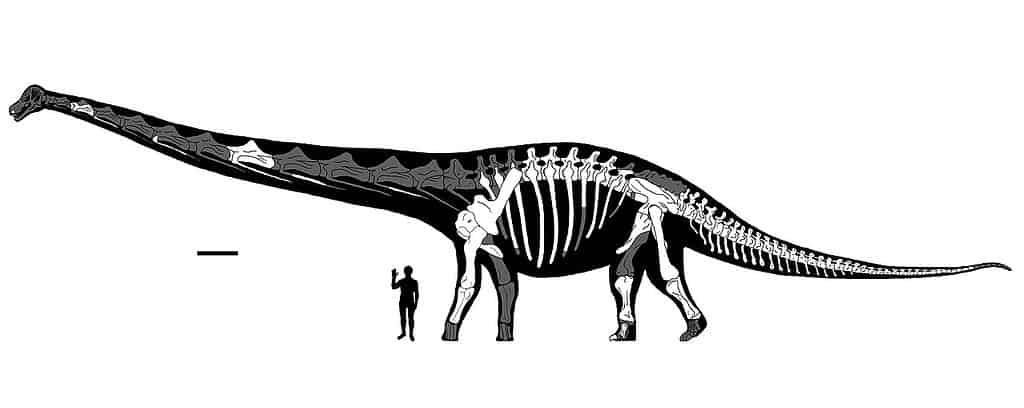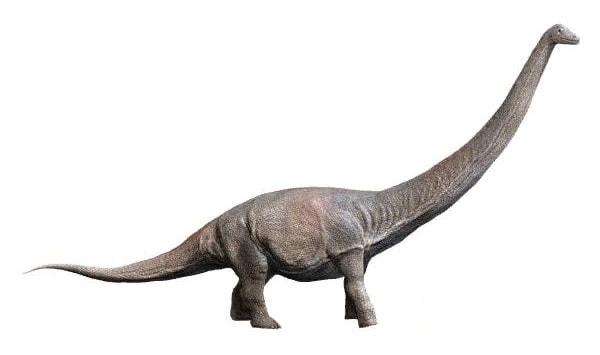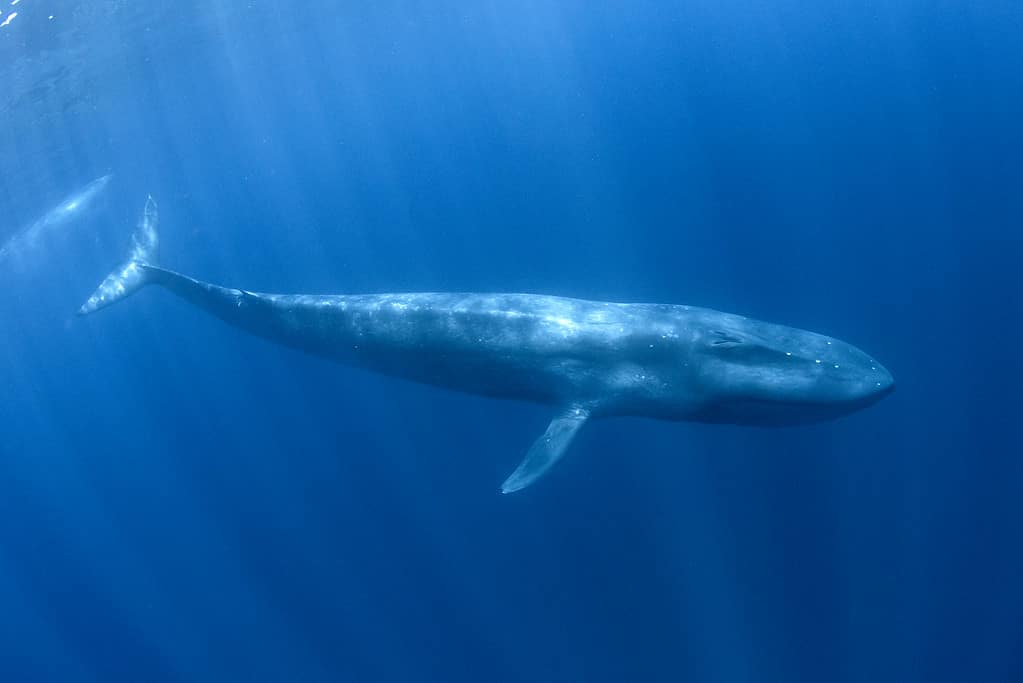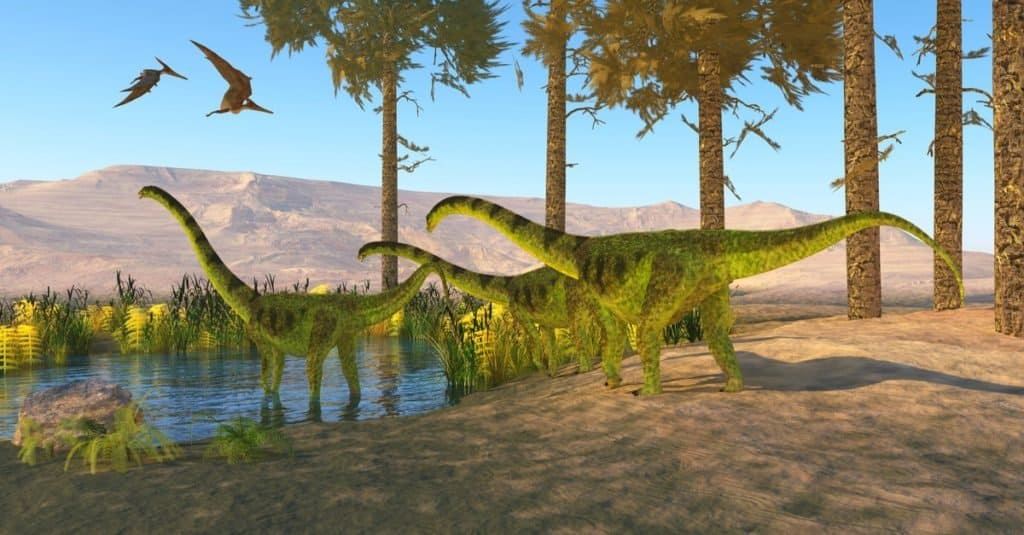The largest land animal that ever lived was dreadnoughtus, a sauropod that weighed an astounding 54 tons. That’s as much as a house! It’s named for a type of early 20th-century battleship, the first of which was the HMS Dreadnought. Read on to find out more about this dinosaur that moved over land like an unstoppable warship.

was the largest land animal ever to live. The bones in white have been discovered in digs.
©ArcaneHalveKnot / CC BY-SA 4.0, via Wikimedia Commons – License
Scientific Classification of Dreadnoughtus
| Kingdom | Animalia |
| Phylum | Chordata |
| Clade | Dinosauria |
| Family | Titanosauridae |
| Genus | Dreadnoughtus |
| Species | D. schrani |

is considered part of the Titanosauridae family of dinosaurs.
©
Description & Size
Dreadnoughtus is a sauropod dinosaur discovered in Argentina in 2005. Fossils of this dinosaur are more complete than any other species of large sauropod. In life, dreadnoughtus was about 85 feet long and weighed an estimated 54 tons. It stood about 20 feet high at the shoulder. Based on its bone structure, paleontologists believe it held its neck out horizontally. If it did raise its neck up vertically, to reach leaves on a high tree, for example, it could reach a dizzying 35 feet off the ground! Measuring from the head all the way to the tip of the tail, dreadnoughtus was 85 feet long. That’s the same as the distance between bases on a standard-sized baseball diamond. And it’s entirely possible that this beast would have been even larger at full adulthood, as the two specimens that have been recovered were juveniles.

was as long as the distance between the bases on a baseball diamond!
©mTaira/Shutterstock.com
Comparison to Other Animals
This chart shows how dreadnoughtus compared in size with other large animals of the past and present. Note that the African bush elephant is currently the largest land animal in the world. The moose is the largest land animal in North America. The blue whale is the largest animal ever to have lived. It is much larger than any dinosaur of the land or sea ever discovered.
| Animal | Length | Height | Weight |
|---|---|---|---|
| Dreadnoughtus | 85 feet | 20-35 feet | 54 tons |
| Diplodocus | 92 feet | 13 feet | 25-30 tons |
| Tyrannosaurus Rex | 40 feet | 12-20 feet | 5-8 tons |
| African Bush Elephant | 24 feet | 13 feet | 11 tons |
| Moose | 9 feet | 6 feet | 1500 pounds |
| Blue whale | 82-105 feet | 13-16 feet | 55-165 tons |
| Human | – | 5 feet 9 inches | 150 pounds |

The modern blue whale is by far the largest animal ever to live. It is twice as long as
dreadnoughtus.©Rich Carey/Shutterstock.com
Habitat and Diet
Dreadnoughtus lived about 77 million years ago, which places it in the Late Cretaceous Period. During this period the world was warmer and more humid than it is today, so much so that there were no polar ice caps. Dinosaurs even roamed across the forests of what is today Antarctica.
Dreadnoughtus was a herbivore that could have eaten from the highest treetops. In view of its size and the enormous weight it needed to maintain, though, it likely would have eaten any vegetation within reach. Some of the plants that lived during this geologic epoch were cycads, conifers, ferns, and ginkgoes. Angiosperms, or flowering plants covered the landscape.

Ginkgo trees were one of the species of flora
dreadnoughtusmay have eaten.
©jessicahyde/Shutterstock.com
Coexisting Dinosaurs
Other fossils recovered in the same formation as the dreadnoughtus were the puertasaurus, the orkoraptor, the austrocheirus isasii, and the talenkauen, as well as turtles and crocodiles. In view of its enormous size, it is unlikely that an adult dreadnoughtus would have any natural predators. The recovered fossils do have teeth marks that are likely from a megaraptoran predator. It appears, though, that the specimens recovered were buried by mud during a flood, though. The teeth marks on the bones could have been made by scavaging after they were dead rather than by a predator that killed them.

The
puertasauruswas a sauropod that lived at the same time as
dreadnoughtusin the Patagonian region.
©Catmando/Shutterstock.com
Why Did Dreadnoughtus Go Extinct?
Most researchers assume that dreanoughtus went extinct during the Cretaceous-Paleogene extinction event that happened about 66 million years ago. It was the result of a large asteroid or comet that impacted the planet at what is today the Yucatan Peninsula of Mexico. It altered the Earth’s climate, causing three-fourths of all living things to go extinct. Sea turtles, crocodiles, and small mammals were among the lucky few to survive this apocalypse.
What would our world be like today if dreadnoughtus and similar massive animals had not gone extinct? It’s difficult to imagine how human beings could have coexisted with them in large numbers. Agriculture would have been impossible, as no wall could be strong enough to keep them from eating entire fields and orchards. Even if they were not aggressive toward people, imagine how they would block traffic, smash their heads curiously into the windows of upper-floor kitchens, or flatten buildings. Only by migrating to protected places like islands or inaccessible mountain valleys could humans hope to build a civilization where their work was not quickly destroyed. All in all, dinosaurs like dreadnoughtus are best enjoyed in fossil form!

Earthquake-scale damage would be commonplace if
dreadnoughtuswalked the Earth today.
©AB-DESIGN/Shutterstock.com
The photo featured at the top of this post is © Nobu Tamura email:[email protected] http://spinops.blogspot.com / CC BY-SA 4.0 – License / Original
Sources
- Carnegie Museum of Natural History, Available here: https://carnegiemnh.org/mesozoic-monthly-dreadnoughtus/
- Britannica, Available here: https://www.britannica.com/animal/Dreadnoughtus
- Drexel University, Available here: https://drexel.edu/news/archive/2014/september/dreadnoughtus-dinosaur
- Scientific Reports, Available here: https://www.nature.com/articles/srep06196
FAQs (Frequently Asked Questions)
When was the Dreadnoughtus alive?
According to fossil dating, this dinosaur lived around 77 million years ago during the Late Cretaceous Period, approximately 100 to 66 million years ago.
How big was Dreadnoughtus?
Using advanced technologies and formulas, researchers believe that Dreadnoughtus weighed up to 65 tons and was up to 26 meters from head to tail. This massive dinosaur had an 11-meter neck and stood around 6 meters tall to its shoulder.
Is Dreadnoughtus bigger than a blue whale?
Dreadnoughtus may have been the largest dinosaur that we’ve ever discovered. However, the Blue Whale remains the largest known animal to ever have existed.
Thank you for reading! Have some feedback for us? Contact the AZ Animals editorial team.






